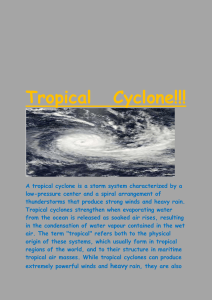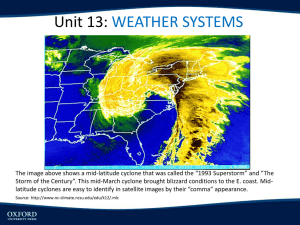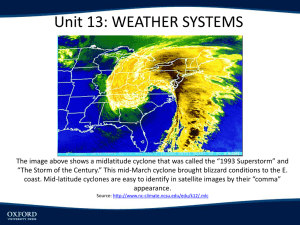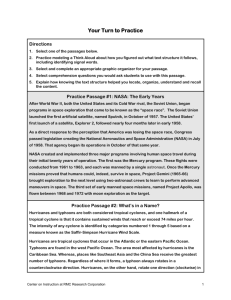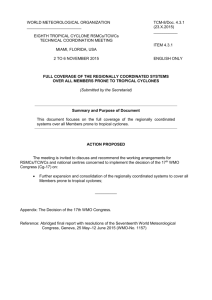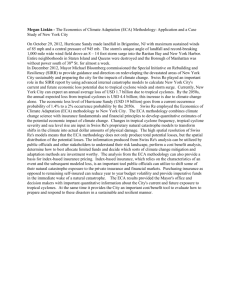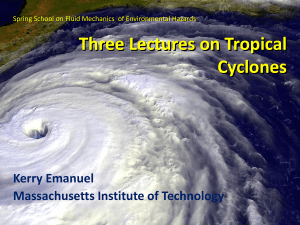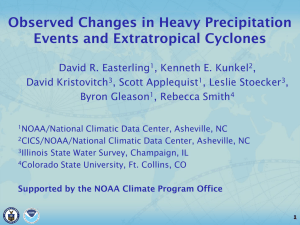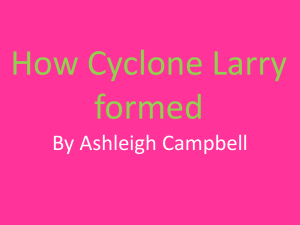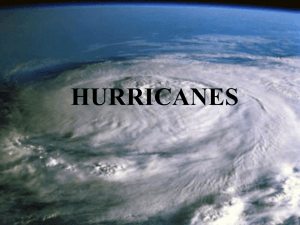Perry
advertisement
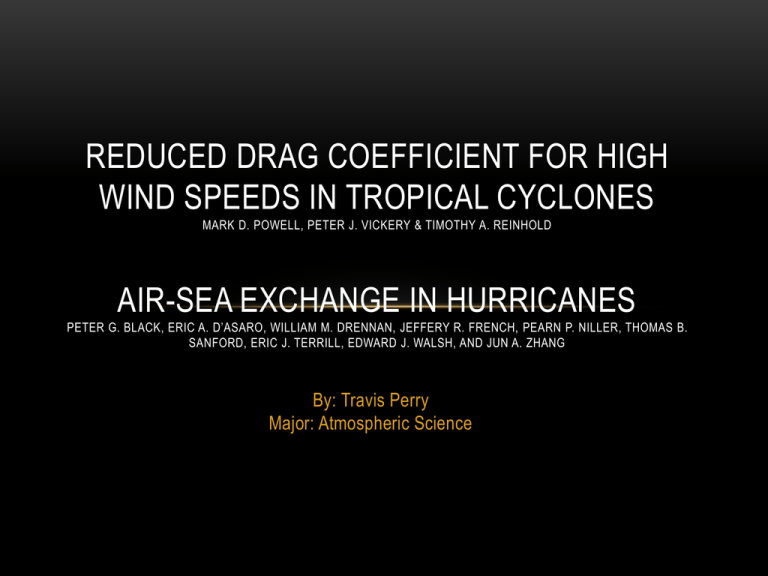
REDUCED DRAG COEFFICIENT FOR HIGH WIND SPEEDS IN TROPICAL CYCLONES MARK D. POWELL, PETER J. VICKERY & TIMOTHY A. REINHOLD AIR-SEA EXCHANGE IN HURRICANES PETER G. BLACK, ERIC A. D’ASARO, WILLIAM M. DRENNAN, JEFFERY R. FRENCH, PEARN P. NILLER, THOMAS B. SANFORD, ERIC J. TERRILL, EDWARD J. WALSH, AND JUN A. ZHANG By: Travis Perry Major: Atmospheric Science TROPICAL CYCLONES (STUFF YOU SHOULD ALREADY KNOW) • Also known as hurricanes, typhoons and cyclones TROPICAL CYCLONE DESTRUCTION AND FATALITIES • Hurricane-scale winds • Rainfall • Storm Surge (winds blowing coastward + lower atmospheric pressure) • Fine-Scale Tornadoes SAFFIR-SIMPSON SCALE HURRICANE INTENSITY SCALE POP QUIZ (HOPE YOU PAID ATTENTION IN 520) • What are 6 necessary environmental conditions for tropical cyclone formation? • 1. SST>27ºC (about 80ºF) • 2. Warm ocean mixed layer thick enough to supply energy • 3. Unstable atmosphere with a moist lower/middle troposphere • 4. Low vertical windshear • 5. Coriolis force (do not form between 5N-5S) • 6. Pre-existing low-level rotating circulations. GLOBAL POSITIONING SYSTEM DROPWINSONDE IMPORTANCE AND PROBLEMS USING THEM • GPS sondes are used to get measurements inside of hurricanes. • Measures pressure, temperature, humidity and position every 0.5 seconds. • Accuracy: wind 0.5-2.0 ms^-1 and height within 2 m • Dropped from 1.5-3 km or higher and falls at 10-15ms^-1 • Problems – Turbulence and intense rainfall can cause signal interruptions or failures to report values. DRAG COEFFICIENT IMPORTANCE AND EQUATIONS • In strong winds, momentum exchange at the sea surface is described by a sea-statedependent drag coefficient. (Cd) • Never been observed in tropical cyclones but used in prediction models • Forecast track, intensity, surface wind speeds, geographic distribution of extreme wind, storm surge and wave forecast. • U=mean wind speed, Ustar=friction velocity, Z=height, Zo=surface roughness length, tao=surface momentum flux, rho=air density, U10= 10-m wind speed, g=gravity MEAN WIND SPEED • Logarithmic increase to max around 500m. • Decrease due to the weakening of the Horizontal PG in warm core of cyclone. • Variability due to convective scale features in eye wall as well as the location of the GPS sonde launch. WIND SPEEDS IN DIFFERENT MEAN BOUNDARY LAYERS REDUCTION OF DRAG COEFFICIENT REASON FOR REDUCTION OF DRAG COEFFICIENT • Foam patches • Formed from steep waves being sheared off by high winds. • Creates a ‘slip’ surface. • GPS sonde errors • Sampling strategy AIR SEA EXCHANGE IN HURRICANES • CBLAST – Coupled Boundary Layer Air-Sea Transfer • CBLAST used to improve TC track and intensity forecast. • Two observational components • 1) airborne in situ and remote sensing instrumentation flown into hurricanes by the two NOAA WP-3D aircraft • 2) air-deployed surface-drifting buoys and subsurfaceprofiling floats. FLIGHT PATTERN FLIGHT PATTERN SINGLE PLANES DRAG AND MOIST EXCHANGE COEFFICIENTS • Red dashed lines are values from previous paper. • Gray circles are CBLAST values. • Each show leveling off or decrease but CBLAST shows leveling off near 2223ms^-1 while previous paper showed leveling off around 33ms^-1 SURFACE WAVE OBSERVATIONS • Wave height – dashed black contours • Wave steepness – thin blue contours • Swell direction – solid black ‘streamlines” • I. Unimodal, short-wavelength and waves move with wind • II. Bimodal longer wavelengths, outward relative to dominant waves moving outward up to 45 degrees relative to wind direction. • III. Unimodal spectra with peak longwavelegnth waves moving outward relative to the wind by 60-90 degrees. FLOATS AND DRIFTERS • SOLO floats profiles temperature, salinity and oxygen • EM-APEX profiles temperature, salinity and velocity • Lagrangian profiles temperatue, salinity and gas concentration • Drifters profile temperature and wind speeds and directions. RELATIONSHIP BETWEEN WIND SPEED, WAVE HEIGHT AND BUBBLE LAYER DEPTH MIXED LAYER DEPTH • Rapid deepening of the mixed layer associated with high shear across the thermocline. • Strong wind and wave forcing directly generates turbulence in the upper 20-40m of the ocean. • SST front created with temperature range of about 27.5-30 degrees Celsius. Cold wake formed from passage with a max decrease of about 3.2 degrees Celsius. SUMMARY AND MY THOUGHTS • Cd leveling off near 2223ms^-1 most likely due to a bubble layer. • Drifter and buoy deployments give us first time ever boundary layer observations. • Cold wakes are formed from passage of Tropical Cyclones. • Great Start in TC research. • Not a lot to disagree with. QUESTIONS?


